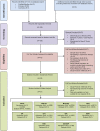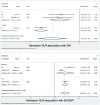Role of Neutrophil-Lymphocyte Ratio in the Prognosis of Acute Ischaemic Stroke After Reperfusion Therapy: A Systematic Review and Meta-analysis
- PMID: 35492740
- PMCID: PMC9052237
- DOI: 10.1177/11795735221092518
Role of Neutrophil-Lymphocyte Ratio in the Prognosis of Acute Ischaemic Stroke After Reperfusion Therapy: A Systematic Review and Meta-analysis
Abstract
Background: Inflammation may mediate response to acute reperfusion therapy (RT) in acute cerebral ischaemia. Neutrophil-lymphocyte ratio (NLR), an inflammatory biomarker, may play an important role in acute ischaemic stroke (AIS) prognostication.
Objective: This meta-analysis sought to examine the effect of NLR on functional outcomes, mortality and adverse outcomes in AIS patients receiving RT.
Methods: Individual studies were retrieved from PubMed/Medline, EMBASE and Cochrane databases. Data were extracted using a standardised data sheet and meta-analysis on association of admission (pre-RT) or delayed (post-RT) NLR with clinical/safety outcomes after RT was conducted.
Results: Thirty-five studies (n = 10 308) were identified for the systematic review with 27 (n = 8537) included in the meta-analyses. Lower admission NLR was associated with good functional outcomes (GFOs), defined as 3-month modified Rankin scale (mRS) 0-2 (SMD = -.46; 95% CI = -.62 to -.29; P < .0001), mRS 0-1 (SMD = -.44; 95% CI = -.66 to -.22; P < .0001) and early neurological improvement (ENI) (SMD = -.55; 95 %CI = -.84 to -.25; P < .0001). Lower delayed admission NLR was also associated with GFOs (SMD = -.80; 95%CI = -.91 to -.68; P < .0001). Higher admission NLR was significantly associated with mortality (SMD = .49; 95%CI = .12 to .85; P = .009), intracerebral haemorrhage (ICH) (SMD = .34; 95% CI = .09 to .59; P = .007), symptomatic ICH (sICH) (SMD = .48; 95% CI = .07 to .90; P = .022) and stroke-associated infection or pneumonia (SMD = .85; 95% CI = .50, 1.19; P < .0001). Higher delayed NLR was significantly associated with sICH (SMD = 1.40; 95% CI = .60 to 2.19; P = .001), ICH (SMD = .94; 95% CI = .41 to 1.46; P < .0001) and mortality (SMD = 1.12; 95% CI = .57 to 1.67; P < .0001). There were variations in outcomes across RT groups.
Conclusion: Higher admission or delayed NLR is significantly associated with worse morbidity, mortality and safety outcomes in AIS patients receiving RT.
Keywords: Stroke; endovascular therapy; intravenous thrombolysis; meta-analysis; neutrophil-to-lymphocyte ratio; overall survival; prognosis; reperfusion therapy; systematic review.
© The Author(s) 2022.
Conflict of interest statement
Declaration of Conflicting Interests: The author(s) declared no potential conflicts of interest with respect to the research, authorship, and/or publication of this article.
Figures





References
-
- Shi C, Killingsworth MC, Bhaskar SMM. Prognostic capacity of hyperdense middle cerebral artery sign in anterior circulation acute ischaemic stroke patients receiving reperfusion therapy: A systematic review and meta-analysis. Acta Neurol Belg. 2021:1-13. doi:10.1007/s13760-021-01720-3. - DOI - PMC - PubMed
LinkOut - more resources
Full Text Sources

